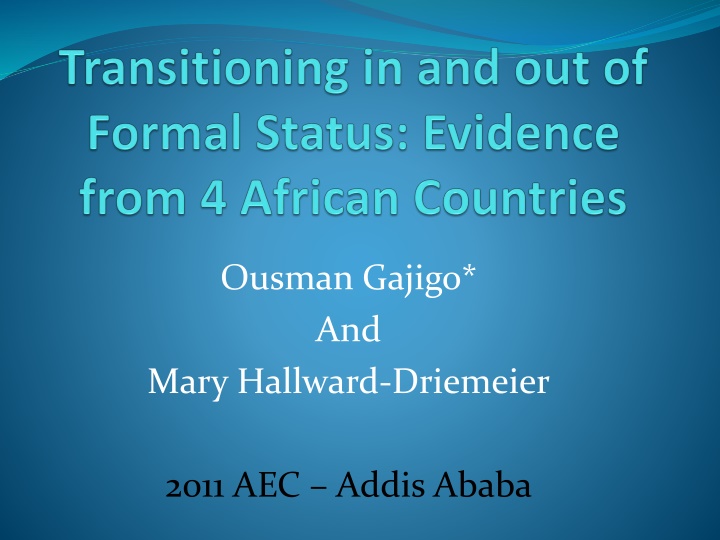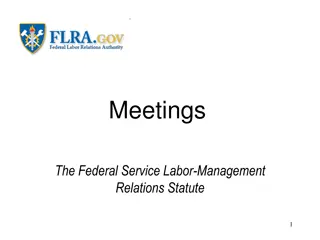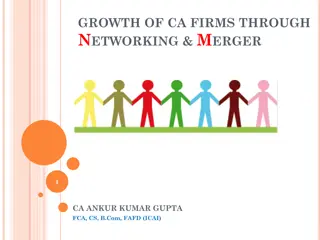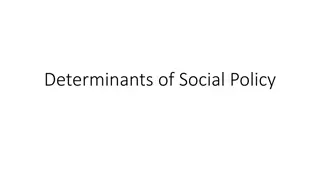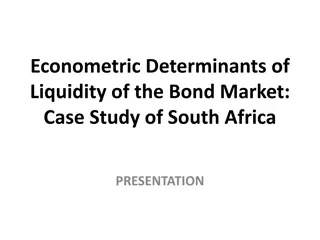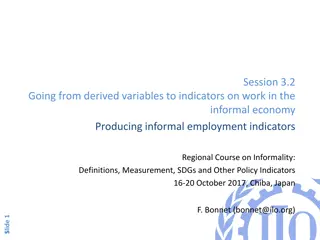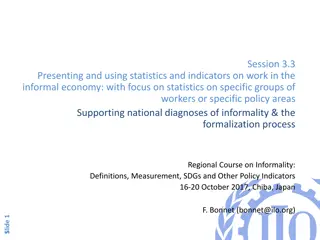Determinants of Formality and Informality in African Firms
This research explores the factors influencing the formal registration of firms in African countries and the impact of transitioning between formal and informal sectors. It delves into the effects on firm performance, access to infrastructure and finance, tax revenue, and worker welfare. The study also analyzes firm ownership types, age distribution, and median start-up capital in relation to formality. Notably, the paper highlights the reasons behind firms transitioning between formal and informal statuses and the implications of such shifts on the economy.
Download Presentation

Please find below an Image/Link to download the presentation.
The content on the website is provided AS IS for your information and personal use only. It may not be sold, licensed, or shared on other websites without obtaining consent from the author.If you encounter any issues during the download, it is possible that the publisher has removed the file from their server.
You are allowed to download the files provided on this website for personal or commercial use, subject to the condition that they are used lawfully. All files are the property of their respective owners.
The content on the website is provided AS IS for your information and personal use only. It may not be sold, licensed, or shared on other websites without obtaining consent from the author.
E N D
Presentation Transcript
Ousman Gajigo* And Mary Hallward-Driemeier 2011 AEC Addis Ababa
Research Question What determines formality/registration of firms? To what extent are government policies or regulations or actions of public officials affecting rate of formality?
Importance of Formal Status Effect on firm performance. Access to Infrastructure and access to finance. Effect on government Broadening the tax base, and therefore tax revenue. Effect on welfare of workers Worker rights more likely to be enforced.
Data Four African countries in 2009/10: Ivory Cost, Kenya, Nigeria and Senegal. Mixture of formal and informal firms across different sectors and ownership structures Information on transitioning between formal and informal sectors.
Size distribution Medium & Large 23% Micro 38% Small 39%
Ownership types Public companies 4% Private held LLC 14% Partnership 16% Sole proprietorshi p 66%
Age distribution 1 .8 .6 prob .4 .2 0 0 10 20 30 40 firm/enterprise age in months
What is new in this paper? Analyzing the determinants of exiting the formal sector for the informal sector. 5% of initially formal firms became informal within 3 years. 23% of initially informal firms became formal within 3 years.
Median Start-up Capital Formal>>Informal: started as formal but currently informal Informal>>Formal: started as informal but currently formal 16000 13790 14000 12000 10000 USD 8000 6158 6000 3343 4000 1103 2000 0
Distributions of Start-up Capital Kernel density estimate .4 Always Formal Always Informal Formal>>Informal Informal>>Formal .3 Density .2 .1 0 0 5 Log of Labor Productivity 10 15 kernel = epanechnikov, bandwidth = 0.2867
Labor Productivity (revenue per worker) Formal>>Informal: started as formal but currently informal Informal>>Formal: started as informal but currently formal 3500 2899 3000 2632 2500 2000 USD 1500 1000 807 315 500 0 Always Formal Always Informal Formal>>Informal Informal>>Formal
Distribution of Labor Productivity Kernel density estimate .3 Always Formal Always Informal Formal>>Informal Informal>>Formal .2 Density .1 0 0 5 10 15 Log of Start-up Capital in USD kernel = epanechnikov, bandwidth = 0.4136
Estimations ? + ?? ? + ?? ? + ?? ??= ?? probit (1) ? = 1 ?? ?????? ?? ????? ?? ??? ????????? ???????? = 0 ?? ?????? ?? ????? ?? ??? ????? ?????? X=owner characteristics (gender, age, education, etc.) W=firm characteristics (size, industry, capital, labor, etc.) Z=policy/govt. variables (time cost of regulations, unofficial payments, etc.)
Regression Results (Probit) Marginal Effects
Coef. -0.002 -0.0002** -0.0001 -0.0004** -0.003*** -0.002** -0.002 -0.001 -0.002 -0.003 z-stat -1.07 -2.36 -0.46 -1.95 -3.38 -2.16 -0.86 -0.38 -0.59 -1.13 Female owner Enterprise age in months Owner age Total # workers at start-up log of labor productivity (revenue per worker) log of start-up capital -USD Largest source of finance at start-up was Trade Credit Largest source of finance at start-up was Money Lenders Largest source of finance at start-up was MFI Largest source of finance at start-up was Bank Largest source of finance at start-up was Friends/Relatives management spent time dealing with govt. regulations % of management's time spent dealing with govt. regulations spent some money on gifts/informal payments to govt. officials % of annual sales spent on gifts/informal payments to govt. officials -0.001 -0.52 -0.003 -1.25 0.000 -0.88 -0.009** -2.19 0.0002* 1.92
Estimation Contd. ??= ?? Probit ? + ?? ? + ?? ? + ?? (2) = 1 ?? ???????? ?? ????? ?? ??? ????????? ?????? = 0 ?? ???????? ?? ????? ?? ??? ????? ???????? ?? X=owner characteristics (gender, age, etc.) W=firm characteristics (size, industry, etc.) Z=policy/govt. variables (regulation requirements, payments, etc)
Coef. z-stat Female owner -0.012* -1.73 Owner age -0.003*** -3.65 Attended some university 0.213** 1.98 Attended some graduate school 0.087 1.28 # years served as an employee of a formal enterprise 0.003*** 2.83 Total # workers at start-up -0.0004 -0.6 log of labor productivity (revenue per worker) 0.019*** 4.91 log of start-up capital -USD 0.006** 1.97 Largest source of finance at start-up was Bank management spent time dealing with govt. regulations % of management's time spent dealing with govt. regulations spent some money on gifts/informal payments to govt. officials % of annual sales spent on gifts/informal payments to govt. officials 0.079** 2.63 0.005 0.5 -0.0002 -0.84 0.046** 2.85 -0.005** -2.84
% of firms that made informal payments or gifts to get things done . 100% 90% 80% 65% 70% 60% 49% 47% 50% 34% 40% 30% 20% 10% 0%
Management/owners spent substantial amount of time meeting govt. regulations. 100% 90% 80% 69% 70% 54% 60% 48% 50% 40% 40% 30% 20% 10% 0%
Conclusion Productivity is a determinant to being in the formal sector. Consistent with findings that formality increases with productivity. Bribe payments limits firm registration by increasing cost. It also shrinks the formal sector. Policy Implication: Streamline registration requirements to reduce both the direct and opportunity cost, as well as bribe payments.
